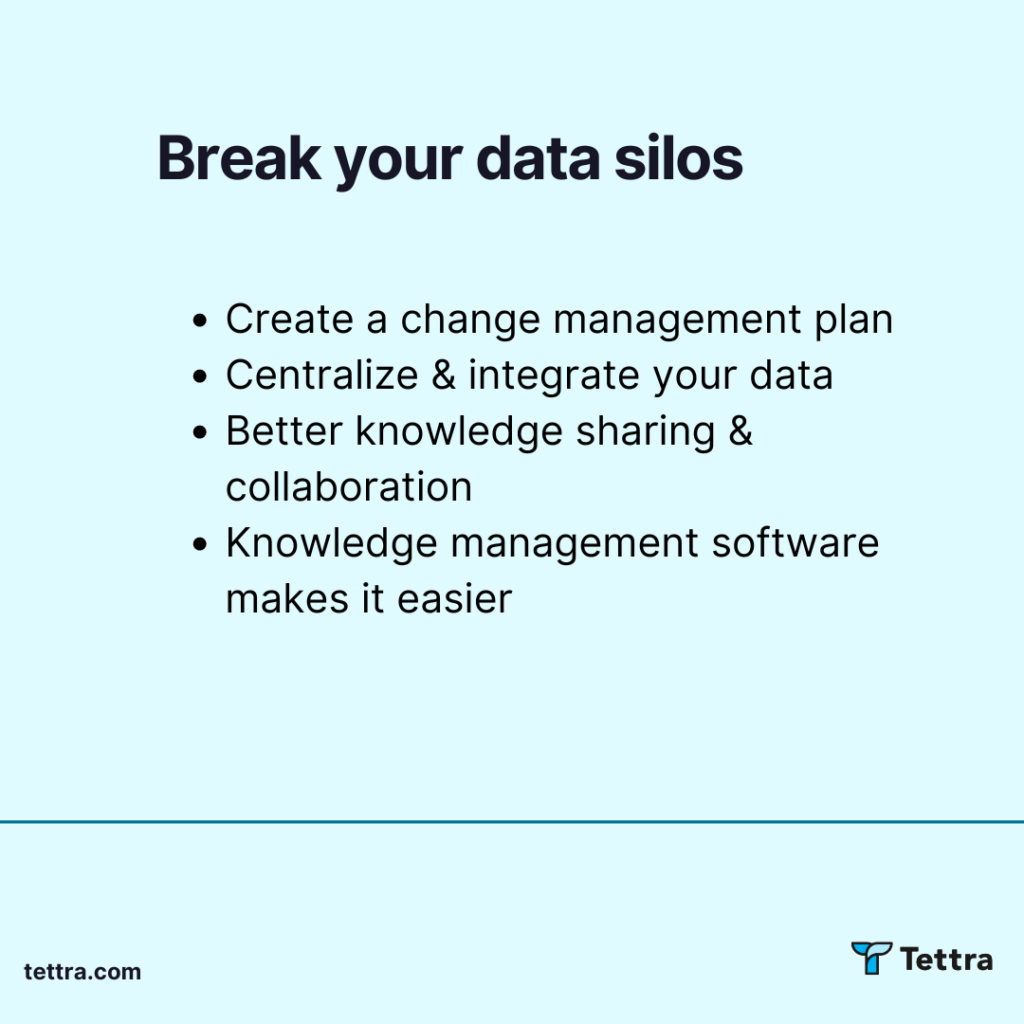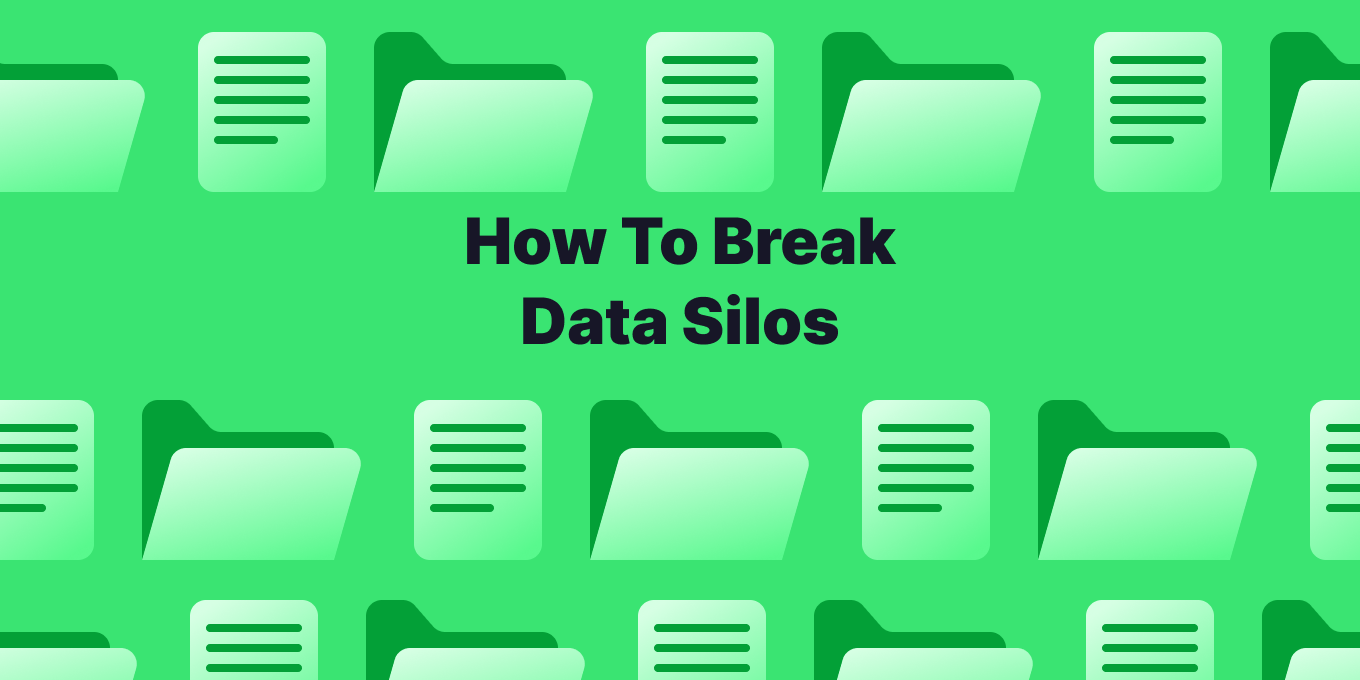Running a business in the modern age can, more often than not, become overwhelming and stressful.
One of those issues concerns data and information, one of the essential commodities in today’s business.
If you’ve found yourself in a situation where your departments are having trouble accessing up-to-date customer service data, if you see duplicate entries, or if you see a sudden spike in customer dissatisfaction, then you have siloed data.
But don’t worry, there’s hope to improve your business data silos.
What is a data silo?
Data silos are isolated repositories of data that cannot be accessed by different departments within a company. They can occur for various reasons, such as faulty system software updates, software integration issues, etc., and are a sign of poor data management mechanisms.
Such issues can spread across the company fast.
But usually, they are isolated to specific departments or people.
If teams cannot access up-to-date information and create analytics accordingly, this may lead to severe company damage. Thus, acting fast and eliminating the issue is crucial for improved productivity.
Why is a data silo a problem?
Data silos within your company can lead to numerous serious issues, affecting your workflow and efficiency. Here are some of the major problems they can cause.
- Efficiency difficulties—Poor data performance and outdated information will make your teams and departments less productive, leading to inconsistent results.
- Communication and collaboration—Without unified and up-to-date data, teams cannot communicate properly, which may lead to workplace stress and other correlated concerns. Many teams use disparate systems, causing communication breakdowns.
- Costs—Experiencing data silos can increase your expenses. You may need more storage and tools to help the situation, and this will cost you time, effort, and money in the long run.
- Customer experience—Your customers may also feel something’s wrong in the organization. If the issue continues, customers may leave bad reviews, impacting your reputation.
Thus, you should act immediately when you notice difficulties regarding your data management capabilities.
Why do data silos occur?
Organizational structure
The structure of your company may be the culprit that leads to data silos. If your departments work independently, data silos are likely to occur over time, causing chaos within the company.
If your business has specialized sectors, such as sales teams, customer support, services, and more, some essential data may become trapped in a specific sector, causing overall productivity concerns.
Company culture
The way your business operates can also lead to data silos. For instance, if communication between teams is poor, and if a specific department is overprotective of their data, you may often experience data silos issues.
People within your company won’t be able to share or use the data, causing it to “pupate” and trap itself in specific silos. According to a recent study, only 22% of businesses claim that sharing data within a company is efficient, which is a very bad statistic.
Technology limitations
One of the leading causes of data silos is the technology you use to preserve data. If you’ve recently replaced your legacy systems with new ones, they may not be able to support your storage resources, trapping the data inside.
Additionally, if all your departments use different technologies, it may lead to accessibility and sharing concerns. The best course of action is to ensure that all company software and hardware are compatible regardless of the department. A good idea is to use a single source of truth across all verticals.
Potential risks of data silos
As we have established, data silos can pose a considerable risk to your business. Here are some of the most prominent potential dangers of data silos.
Limited data visibility
Once data silos occur, departments won’t have a comprehensive insight into up-to-date information, leading to overall data “blindness.” It further leads to inconsistencies and misinformation.
Threat to data integrity
Since data won’t be consistent, and your team may not be able to react fast regarding data validation, you might be left with poor data integrity. This further impacts the customer experience, productivity, and workplace communication.
Wasted resources
Maintaining and storing your data requires specific resources. If you are experiencing data silos, these resources may be wasted, thus increasing maintenance costs.
Lack of collaboration
As previously mentioned, data silos will affect data integrity and visibility, leading to poorer communication and collaboration within your company. Everyone will have different information, causing workplace stress.
Best practices to handle data silos
To avoid and escape data silos scenarios, you must prepare accordingly. Talend, a prominent name in the data management world, proposes four solutions to deal with such concerns.
1. You need to change management
When you notice data silos are forming, act instantly and start creating a change management plan. The first step is to examine the situation and create a strategy to break down silos accordingly. You can also contact professionals for this step and save time and nerves in the process.
Once you start using the strategy, follow the results and see whether you can add elements to your plan to make it more efficient.
2. You need to centralize and integrate your data
Data centralization can be crucial for your business, especially if it operates in several sectors.
This will grant everyone access to the newest data, leading to better communication and the release of data “traps.”
The most important thing during this transition is to use as many automated tools as possible. You’re already late to the digital transformation, but it’s not too late to join in.
A study has found that efficient data management surely impacts innovation within a firm, so you’ll see a boost in productivity and efficiency as soon as you centralize data.
3. You need better knowledge sharing
One of the most important things that will break down and minimize the chances of data silos is improving collaboration within your company.
Sharing your knowledge with others.
You know, talk to each other.
Encourage departments to work together, share their experiences, and export essential data so everyone has an insight.
You should use the digital advancements of the modern era. Invest in collaboration tools so employees can easily contact one another within the organization and get the desired data in seconds.
4. You need knowledge management software solutions
One of the most productive and efficient methods you can use to resolve the issue and break down data silos is to try knowledge management software solutions. Such tools can quickly categorize your data, and thanks to the latest technologies, you can try AI-based systems for a more streamlined experience.
Take Tettra as an example. This knowledge base tool allows you to use custom indexing and tagging to organize your documents accordingly. Moreover, AI-powered systems will provide recommendations based on your specific situation.
Information silo, banished!
It’s a different system and way for managing your team data and knowledge. You will genuinely turn your whole business experience upside down and allow you to manage your data in a much better way without the need for anyone to leave their office desk. I

Why is it important to break data silos?
You may think that data silos are not your top priority. In some instances, you may be correct. If you are experiencing even more pressing matters, it is logical to tackle them first.
Nevertheless, if you ignore data silos and let them build up, you might realize the significance of this mistake when it’s too late. Thus, let’s explore why it’s crucial to react and break down data silos ASAP.
Improved decision-making
Once you break data silos down, your company will have a comprehensive insight into all the data circling around, allowing them to make informed decisions based on backed-up information. They won’t have to improvise their way out of a situation since they’ll have all the information they need to resolve the problem.
All this leads to better decision-making skills, ultimately impacting your workflow and growth. Your future business-leader self will thank you for making this happen.
Holistic view of data
Centralizing your data and getting rid of data silos will provide a holistic or interconnected view of company data. For instance, teams will have insights into customer experiences, related products/services, and reports, all in one place.
Once you gain a holistic view of data, you can focus on what’s really important and reach your desired goals accordingly.
Optimized business efficiency
Last but not least, your business efficiency will skyrocket when you eliminate problematic data silos from your company. It will allow you to streamline your data better, leading to automated business processes and higher efficiency. Moreover, once all of your data is in one place, you’ll save space by eliminating duplicate files.
Your team will have zero boundaries or limitations. You will foster a stress-free, welcoming, and productive workplace environment, which is something all business owners should strive to achieve.
After all, more than 35% of employees are more likely to be absent from the office if they consider it stressful. By taking the burden off your teams’ shoulders, you will let them be their true, productive selves in the workplace.
Use Tettra to break data silos
Because it centralizes information and provides easy access to up-to-date data, Tettra is an excellent knowledge management software tool to help organizations manage and eliminate data silos.
Here’s why Tettra stands out as a top solution for managing data silos:
- Centralized Knowledge Base: Tettra provides a single source of truth for all company information, ensuring that all departments have access to the same accurate and up-to-date data.
- Custom Indexing and Tagging: With custom indexing and tagging features, Tettra allows teams to organize documents and data efficiently, making information retrieval quick and intuitive.
- AI-Powered Recommendations: Tettra’s AI-based system offers smart recommendations, helping users find relevant information based on their queries and needs.
- Seamless Integration: Tettra integrates with popular tools like Slack and G-suite, ensuring smooth workflows and reducing the risk of data becoming siloed in disparate systems.
- Collaboration and Communication: By fostering a culture of collaboration, Tettra helps break down barriers between departments, promoting better communication and teamwork.
In summary, Tettra’s robust features and seamless integration capabilities make it a powerful tool for managing data silos, enhancing productivity, and improving overall business operations.


